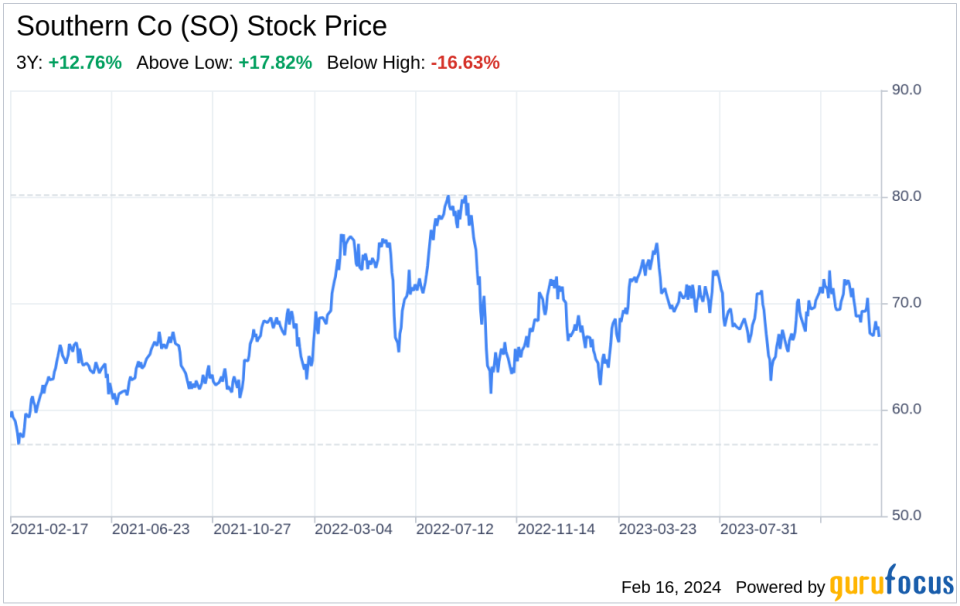Decoding Southern Co (SO): A Strategic SWOT Insight
Comprehensive SWOT analysis based on Southern Co's latest SEC 10-K filing.
Financial overview highlights Southern Co's robust market presence and strategic initiatives.
Exploration of Southern Co's operational risks and forward-looking strategies.
Assessment of Southern Co's competitive positioning and future growth potential.
On February 15, 2024, Southern Co (NYSE:SO) filed its 10-K report with the SEC, providing a detailed overview of its financial health and strategic direction. As one of the largest utilities in the U.S., Southern Co serves 9 million customers and owns a significant 50 gigawatts of rate-regulated generating capacity. The company's financial tables reveal a solid balance sheet, with a diverse energy portfolio that includes 13 gigawatts of natural gas generation and renewable energy. This SWOT analysis aims to dissect the intricate details of Southern Co's SEC filing to offer investors a clear picture of the company's strengths, weaknesses, opportunities, and threats, thereby informing investment decisions and driving engagement on GuruFocus.com.

Strengths
Vertically Integrated Utilities and Diverse Energy Portfolio: Southern Co's strength lies in its vertically integrated electric utilities and a diverse energy portfolio that includes renewable energy projects. With a commanding presence in Georgia, Alabama, and Mississippi, the company's 50 gigawatts of rate-regulated generating capacity ensures a stable revenue stream. Southern Power's 13 gigawatts of natural gas generation and renewable energy assets across the U.S. further solidify its market position, with long-term contracts providing financial predictability and resilience against market volatility.
Robust Infrastructure and Technological Advancements: Southern Co's investment in infrastructure and technology positions it as a leader in the utility sector. The company's digital wireless communications network, Southern Linc, covers approximately 122,000 square miles, enhancing operational efficiency and customer service. Furthermore, Southern Co's commitment to developing distributed energy and resilience solutions, including microgrids, showcases its forward-thinking approach to energy management and its potential to capitalize on emerging market trends.
Weaknesses
Operational Risks and Cybersecurity Concerns: Southern Co's operational performance is subject to risks such as equipment failures, natural disasters, and cybersecurity breaches. The company acknowledges the potential for significant disruptions from cyberattacks, which could impact critical infrastructure and data security. Despite robust security measures, the threat of sophisticated cyberattacks remains a persistent concern, necessitating ongoing investment in cybersecurity defenses and incident response capabilities.
Regulatory and Environmental Challenges: The utility industry is heavily regulated, and Southern Co faces challenges related to environmental compliance and changing regulations. The SEC's proposed rules on climate-related disclosures could increase compliance costs and litigation risks. Additionally, Southern Co's reliance on fossil fuels, including natural gas, may be affected by future carbon constraints and legislative efforts to limit the use of natural gas in certain applications, potentially impacting demand and competitive positioning.
Opportunities
Renewable Energy Expansion and GHG Reduction Goals: Southern Co has set ambitious goals to reduce greenhouse gas (GHG) emissions, aiming for a 50% reduction by 2030 and net-zero emissions by 2050. The company's strategy includes diversifying its energy portfolio with low-carbon and carbon-free resources, which presents significant growth opportunities. The expansion into renewable energy aligns with global trends and customer demand for sustainable energy solutions, offering a pathway to long-term growth and market leadership.
Strategic Acquisitions and Market-Based Rates: Southern Power's strategy to create value through acquisitions, dispositions, and sales of partnership interests positions the company for strategic growth. By committing to new generating capacity only after securing long-term PPAs, Southern Power mitigates risk and capitalizes on market-based rates, enhancing its competitive edge in the wholesale market.
Threats
Geopolitical Conflicts and Economic Conditions: Global and U.S. economic conditions, including impacts from geopolitical conflicts, recession, inflation, and financial market conditions, pose significant threats to Southern Co's operations. Economic downturns can affect customer demand and access to capital markets, while geopolitical tensions can exacerbate the risk of physical and cyberattacks on critical infrastructure, potentially leading to operational disruptions and financial losses.
Competition and Technological Disruption: The energy sector is experiencing rapid technological changes and increasing competition from alternative energy sources. Southern Co must navigate the competitive landscape by continuously innovating and adapting to technological advancements. The shift towards electrification in various sectors, including transportation and building, may also challenge the demand for natural gas, requiring strategic responses to maintain market share and profitability.
In conclusion, Southern Co's SWOT analysis reveals a company with a strong market presence, bolstered by its vertically integrated utilities and diverse energy portfolio. However, it must navigate operational risks, cybersecurity threats, and regulatory challenges. Opportunities for growth lie in renewable energy expansion and strategic acquisitions, while threats from economic conditions and competition must be carefully managed. Southern Co's forward-looking strategies, including its commitment to GHG reduction and market-based rates, position it to leverage its strengths and address its weaknesses in the evolving energy landscape.
This article, generated by GuruFocus, is designed to provide general insights and is not tailored financial advice. Our commentary is rooted in historical data and analyst projections, utilizing an impartial methodology, and is not intended to serve as specific investment guidance. It does not formulate a recommendation to purchase or divest any stock and does not consider individual investment objectives or financial circumstances. Our objective is to deliver long-term, fundamental data-driven analysis. Be aware that our analysis might not incorporate the most recent, price-sensitive company announcements or qualitative information. GuruFocus holds no position in the stocks mentioned herein.
This article first appeared on GuruFocus.
